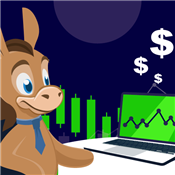Best Investment Magazines
The Economist, Bloomberg Businessweek, and Money made the cut—but so did these other four must-read investment magazines.
 |
These magazines offer investment, personal finance, and economic insights:
- The Economist for global coverage
- Bloomberg Businessweek for a broader ecosystem
- Money for novice investors
- Barron's for deep dives
- Kiplinger's for average readers
- Investor's Business Daily for stock analysis
- Financial Times for expert investors
Ever feel like you're racing to keep up with the investing world?
Markets constantly shift, trends emerge, and new opportunities appear every day. For entrepreneurs, access to trustworthy and relevant information is essential for making informed decisions.
Check out several top publications that consistently deliver valuable investment insights without the fluff.
7 Best Investment Magazines
Whether digital or print, the best investment magazines offer a deeper understanding from seasoned finance writers, market analysts, and industry experts. These voices break down complex topics and spot emerging trends others might miss.
Let's start with a publication known for its wide range of perspectives and international scope.
Financial magazines can be worthwhile if they align with your learning style and passions. If you're using them as a way to learn about the finance world, choose ones written in simpler language. For active investors, you can benefit from the diverse viewpoints and long-form content of such materials.
The Economist: For Global Coverage
Format: Digital and print
Frequency: Weekly digital and printed edition
| Subscription | Regular Fees (Seasonal discounts may apply)[1] |
|---|---|
| Espresso app | $7.90/mo. or $79/yr. |
| Digital | $22.90/mo. or $229/yr. (multi-year offers available) |
| Digital + Print | $31.90/mo. or $319/yr. (multi-year offers available) |
For a comprehensive view of the global landscape, many turn to The Economist, which seamlessly weaves together economics, business, finance, and even politics. "The World This Week" section is particularly valuable for looking beyond the local market.
At the same time, the Economist doesn't just report the news worldwide—it digs deeper into various topics.
Take its 2023 piece "How the young should invest," for example. Instead of just throwing investment tips, it walked readers through the historical context. It also showed where things might be heading and offered actionable advice.
Furthermore, The Economist's coverage extends to cultural and scientific developments. Its special reports often delve into subjects like climate change or technological innovation. They offer insights that are both broad in scope and deep in analysis.
According to The Economist, it's neither Democrat nor Republican. Instead of fitting neatly into the left or right camp, its goal is that its content is about ideas based on their merits, not political ideology.
Bloomberg Businessweek: For a broader ecosystem
Format: Digital and print
Frequency: Monthly print edition
| Subscription | Fees (Introductory discounts available)[2] |
|---|---|
| Digital | $34.99/mo. or Auto-renews at $299 annually after 1 year introductory period |
| Tech Newsletter Bundle | $11.99/mo. |
| Annual Access + Businessweek Print | Auto-renews at $329 annually after 1 year introductory period |
| Student Subscription | $9.99/mo. until graduation |
Let's talk about Bloomberg Businessweek—a heavy hitter in the investment world for good reason. It's read by top investors, CEOs, policymakers, and professionals in finance for its forward-thinking journalism, which is crucial especially when it comes to investing.
On "The Interview Issue" published in 2016, it featured Q&As with business icons like Carlos Slim. The diverse voices provided rich insights into future directions in business, technology, culture, and societal norms.
Often, the magazine creates iconic covers to frame its narrative and hard data. That same year, Jeff Bezos posed like a superhero, partially clad in an Amazon box. It's quirky yet symbolic of Amazon's expansive growth and venture into new territories.
But what gives Bloomberg Businessweek the edge? Its integration with Bloomberg's vast ecosystem. This includes a range of services like Bloomberg Terminal and Bloomberg Intelligence, making for content that's more current and data-driven than others.
Bloomberg L.P. is the parent company of Bloomberg Businessweek, a publication focused on long-form business journalism. It was formerly known as BusinessWeek until it was sold by McGraw-Hill to Bloomberg in 2009.
Money: Best for novice investors
Format: Digital access to website
Frequency: Weekdays
Fee: Free
True to its name, Money is all about helping you manage your money. It has articles on money-saving tips, investing wisely, planning for your retirement, and getting out of debt.
Think of it as your friendly guide to financial literacy. It breaks down complex financial concepts into understandable terms. If you're new to investing, Money.com's beginner guides to stocks and bonds can help you get your feet wet without feeling overwhelmed.
That said, Money.com may not be the best source of in-depth stock analysis or technical trading strategies. While it's great for the basics, it doesn't quite match the detailed investment coverage you'd get from paid financial publications.
Money.com and Money Magazine are from the Money brand but are not the same entity. Money Magazine was a monthly print magazine by Time Inc. which ceased publication in 2019. It has since evolved into a digital platform as Money.com—now managed by Money Group.
Barron's: For Deep Dives
Format: Digital and print
Frequency: Weekdays (digital), Saturdays (printed edition)
| Subscription | Regular Fees (Introductory discounts available)[3] |
|---|---|
| Barron's | $19.99 + tax every 4 weeks |
| Barron's + MarketWatch | $22.99 + tax every 4 weeks |
| WSJ+ | $54.99 + tax every 4 weeks |
| Barron's Print + Digital | $29.99 + tax every 4 weeks |
Since 1921, Barron's has been doing one thing and doing it really well: diving deep into financial markets and investment strategies. When Barron's speaks, Wall Street tends to listen.
Instead of quick market updates, Barron's takes the long-form route of journalism coupled with spot-on commentary.
In a cover story entitled "Why the Widening Wealth Gap Is Bad News for Everyone," it highlighted the issue of income inequality in the US. It went beyond surface-level stats, examining historical data, trends, and future projections on wealth distribution.
And here's something investment pros look forward to every year: the Barron's Roundtable. This is where top investors like Mario Gabelli and Scott Black reveal their best stock picks for the year. When these veterans share their insights, you can bet many traders are taking notes.
While both are owned by Dow Jones, The Wall Street Journal and Barron's differ in focus. Barron's provides long-term strategies, in-depth market analysis, and personal finance. On the other hand, WSJ delivers daily business news, including real-time market updates and political news affecting markets.
Kiplinger's: For Average Readers
Format: Digital and print
Frequency: Monthly
| Subcription | Fees (includes promotional discounts)[4] |
|---|---|
| Digital | 12 monthly issues for $29.95 or 24 monthly issues for $49.95 |
| 12 monthly issues for $29.95 or 24 monthly issues for $49.95 | |
| Print + Digital | 12 monthly issues for $29.95 or 24 monthly issues for $49.95 |
| Note: Regular subscription is $95.40 for 12 monthly issues. Sales tax may apply. | |
Like Money.com, Kiplinger's isn't trying to teach you complex Wall Street strategies. Instead, it's centered on what usually matters to most people, which is providing smart ways to manage money.
As a reader-friendly magazine, Kiplinger's has mastered the art of breaking down financial topics into bite-size knowledge.
When it tackles big subjects like "Three Ways President Trump Could Impact the Economy," Kiplinger's serves them up in clear, digestible information. This helps you find exactly what you need without getting lost in financial jargon.
So instead of saying monetary policy, for example, it might explain it as trying to cool down an overheating economy when the Federal Reserve raises interest rates. That way it's easy to understand because Kiplinger's speaks your language.
Once family-owned, Kiplinger was bought in 2019 by Dennis Publishing, an international media group.
Investor's Business Daily: For stock analysis
Format: Digital and print
Frequency: Weekly Print Edition
Fees: IBD Digital + Print: Auto-renews at $41.95/mo. after the initial introductory period or $389/yr.[5]
Investor's Business Daily (IBD) is a financial news powerhouse known for its distinctive approach to identifying high-growth potential stocks. While it covers stock markets, international business, finance, and others, it's got something special.
Heard about CAN SLIM? It's IBD's investment strategy to identify stocks with the potential for significant price increases. Developed by its founder William O'Neill, CAN SLIM stands for the following seven characteristics:
- Current earnings
- Annual earnings
- New products or management
- Supply and demand
- Leader or laggard
- Institutional sponsorship
- Market directions
IBD's daily content, including stock charts, analyses, and editorial pieces, often emphasize CAN SLIM. Its proprietary stock lists like the IBD 50 also use this criteria. Other lists featured regularly are IBD Sector Leaders, Big Cap 20, and Stock of the Day.
The Financial Times: For expert investors
Format: Digital and print
Frequency: Monday-Saturday
| Subscription | Regular Fees (Seasonal discounts may apply)[7] |
|---|---|
| Trial offer | $1 for 4 weeks, auto-renews to $75/mo. |
| Standard Digital | $45/mo. or $429/yr |
| Premium Digital | $75/mo. or $719/yr. |
| $75.00 per quarter. Introductory offer available. |
Often cited in academic and professional discussions on finance, Financial Times (FT) is a true heavyweight in financial journalism for over a century. This pink paper has seen it all, from market booms to global crashes, and yet it's still leading the pack.
Have you checked out its flagship investment column Lex? Do if you want a sharp, on-point analysis of companies and markets. Whether you're curious about tech stocks, commodity trends, or the latest in sustainable investing, FT dives deep into each.
Then, there's FT Alphaville, a blog that keeps things casual but doesn't skimp on the meat. It often shares market trends before they hit the mainstream, so it's like getting market insights from your smartest friend working at Wall Street.
Now that your choices have been pared down to the best, read on for a few more things to guide your pick.
How to Choose the Best Investment Magazines
A good investment magazine typically combines key elements to be both informative and valuable to readers.
Here are some considerations:
- In-depth analysis
Detailed breakdowns of market trends, economic indicators, and investment strategies help you understand complex financial landscapes. - Relevance
This is important especially when eyeing investment opportunities. The magazine should keep its finger on the pulse of what's happening and what their readers care about. - Readability
Complex ideas should be explained very well without oversimplifying information. - Diverse perspectives
One-sided opinions aren't helpful. Having different analysts or schools of thought, like value investing vs. growth investing, can offer a balanced view. - Value for money
Many good investment publications aren't free, so the content should justify its cost.
Alternatives to Investment Magazines
Looking for other ways to stay on top of the investing world? Here are options across different formats and platforms:
- Online financial news websites like Yahoo Finance, Investing.com, or blogs such as Motley Fool, to name a few.
- YouTube channels that provide investment tips and financial education, like Graham Stephan and ThePlainBagel.
- Investment books that teach investing strategies and market behavior, such as "The Intelligent Investor," a classic written by Benjamin Graham.
- Investment newsletters like Seeking Alpha and Morningstar for stock picks.
- Investing apps such as Acorns and Robinhood.
These alternatives offer insights on investment and related topics.
Methodology
We didn't just randomly grab names off the internet. Instead, we did our homework and actually read several featured articles to see if they delivered solid, trustworthy content.
Don't be surprised to see some websites and newspapers mixed in with traditional magazines. We believe that the format matters less than the quality of insights you're getting.
In addition, we paid attention to their subscriber numbers, too. Think about it—when people are willing to open their wallets for a subscription that isn't exactly cheap, it's pretty telling.
Bottom Line
Finding the best investment magazine can be a cornerstone in building financial literacy. Kiplinger's and Money are ideal for beginners dipping their toes in the investment world.
Meanwhile, Barron's and Financial Times' data-driven information help seasoned investors make confident investment choices.
The journey to becoming a savvy investor is always evolving. With the help of the right publication, you can avoid pitfalls while seizing investment opportunities you would have missed otherwise.
References
- ^ The Economist. Choose the Best Subscription, Retrieved 1/16/2025
- ^ Bloomberg. Bloomberg, Retrieved 1/16/2025
- ^ Barron's. Financial Freedom Comes from Smarter Investing, Retrieved 1/16/2025
- ^ Kiplinger's. Kiplinger's Personal Finance, Retrieved 03/08/2025
- ^ Investor's Business Daily. We Help You Maximize Your Profits, Retrieved 1/16/2025
- ^ Investor's Business Daily. IBD Has Helped Affluent Investors Reach Their Goals, Retrieved 1/16/2025
- ^ Financial Times. Choose from Our Latest Offers, Retrieved 03/08/2025
Write to Penelope Besana at feedback@creditdonkey.com. Follow us on Twitter and Facebook for our latest posts.
Note: This website is made possible through financial relationships with some of the products and services mentioned on this site. We may receive compensation if you shop through links in our content. You do not have to use our links, but you help support CreditDonkey if you do.
|
|
| ||||||
|
|
|












